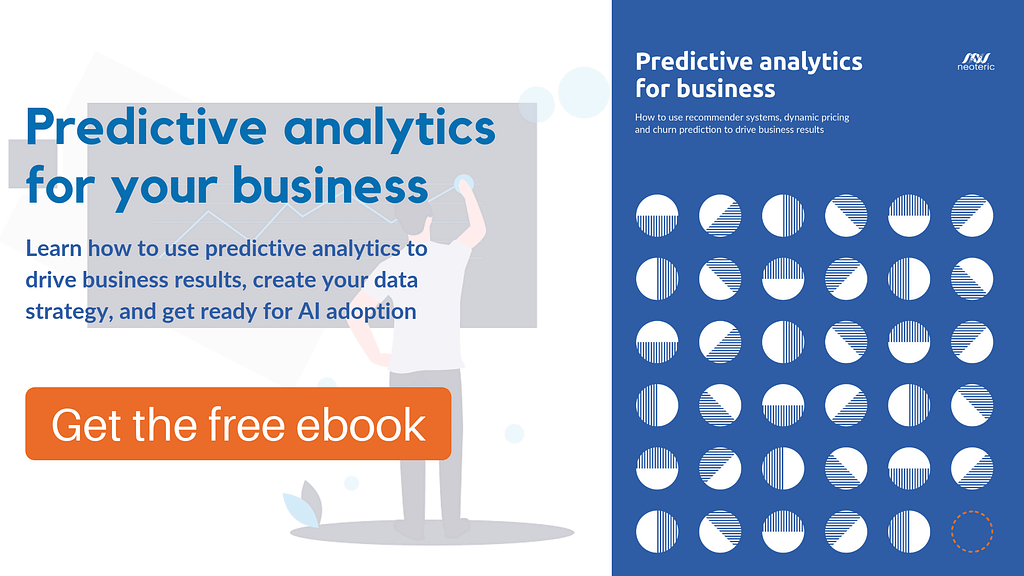The sins of AI adopters, part 3: when you don’t focus on people quite enough
Adopting a new technology can make us lose sight of the people we work with. Not forever, of course, but even when you implement AI, there are certain roles that people play, and it won’t change. Artificial intelligence is not a replacement to all human work, it’s rather an augmentation aimed to increase efficiency and improve performance. Looking at the rapid development of artificial intelligence technologies, it’s easy to assume that people will be redundant. While I don’t want to argue about the future of AI, I definitely think that we currently largely overlook the role of people in AI. And that’s a mistake.
Humans and AI join forces
With AI, it’s important to understand that implementing the solution does not just revolve around technology. One part is the tech, sure, but then there’s your business, which is at the heart of your project, and I’m pretty sure your business is made up of humans. What I mean by that is: you work with people, people do important tasks, people struggle with some issues, but people got you to where you are now. People make your company what it is. Without them, will your business be the same?
Now, obviously some companies don’t require hiring thousands of people. At other times, processes can be automated not to need any human supervision. However, to this point, I have never seen a company without people.
Is artificial intelligence a threat to people on the job market (for the time being, let’s forget the questions about existential threats)? To some extent, perhaps. Various research papers, studies, and documentaries cover the future of work, and in no scenario are people 100% gone from the market, as some obsolete tool. Humans and AI join forces to create a new future of work.
The lesson for today is: never underestimate the role of people, even in AI.
Let’s have a close look at some possible scenarios.
Scenario 1: I made a decision to give my team AI
And it’s probably a wise, educated decision that you made based on market research, business analysis and so on. Now talk to me: How do you imagine the process of AI implementation?
If you’ve already read the previous articles from this series (The lack of data strategy, The mismatch of business and tech), you know the importance of creating a data strategy, taking a careful look at your business needs and processes, and assembling a team that will deliver. What’s also important at these early stages is to make sure you bring AI to your company to benefit people.
The employees and even your partners may have mixed feelings about this change. Some of them will be skeptical because they don’t believe in the “power” of AI, some of them will be afraid of losing their job, others will worry how AI will change the way they work and whether they will be able to work out ways to use the system to their advantage. Your job as a leader is not just to make a decision to implement AI, but also to make sure your company is ready for it, and to learn how your staff can benefit from AI-driven solutions. If your model is supposed to help you increase sales, the data science team will sit down with you or the managers AND the sales representatives from your company. The system will support them in their everyday work, so they know what they need it to do: what questions they need answered, what data shown. They’re also the people who are able to describe the sales processes step by step, so the potential for AI augmentation can be assessed. The decision about AI is a joint effort.

Scenario 2: I want to replace my staff with AI
You may not see it as replacing, but you surely realize the benefits of delegating tasks to AI. Everything happens fast, it works 24/7, no sick leaves, no social insurance, no income tax. Having a system do stuff seems to be more profitable and less risky than hiring people. It’s not that simple, though.
Success stories of companies such as Amazon that use AI in a variety of ways and automate as much as can be automated can inspire founders to think about having employee-free workplaces. Right now, that’s not possible, but in my opinion, it’s also not the way to go. For sure, some jobs will be “killed” by AI, while others will emerge. The same happened with the industrial revolution, and even though we can’t be sure what the future will look like, it’s reasonable to assume that not all work will be automated.
AI solutions, though outsmarting us at repetitive and time-consuming tasks, are not as flexible and adaptable as we are. They can be “creative” as shown by the examples of gamer AI systems beating the champions and receiving acclaim for “creative moves” or even generative design exploring hundreds of options of building an item. However, human intelligence and creativity are still not clearly defined, and thus can’t be copied and replaced.
In an article Collaborative Intelligence: Humans and AI Are Joining Forces, authors H. James Wilson and Paul R. Daugherty write:
Certainly, many companies have used AI to automate processes, but those that deploy it mainly to displace employees will see only short-term productivity gains. In our research involving 1,500 companies, we found that firms achieve the most significant performance improvements when humans and machines work together.
So it’s a fact: AI and humans can work together successfully. Dr. Christian B. Westermann in an interview for our ebook Predictive Analytics for Business, said:

However, there is one important thing to remember here: we have to work with AI, and not against it. Due to the fact that we fear changes that may be brought by this disruptive technology, and many people arguing that human work is doomed, we’re reluctant to embrace the change. Can we stop the development of technology? Rather improbable. Instead, we can use it for the betterment of our lives and work together.
Scenario 3: I have to build my in-house data science team, fast!
I’m afraid it can’t be done. Not fast, definitely. Unless you have a budget the size of Google’s. Building an in-house data science team is costly and time-consuming. It may also be quite far-fetched. There is a shortage of data science experts everywhere, and the experienced ones are often involved in engaging projects with big companies. Assembling your own team can be a real challenge, and to some extent, an unnecessary one. Andrew Ng, one of top AI experts, says that outsourced partners with deep technical AI expertise can help you gain that initial momentum faster. He recommends building your in-house team later on. Because the first AI projects, especially for organizations without much AI know-how, can be risky if not conducted well, it’s reasonable to start small, implementing one AI function and building a proper data strategy.
A good AI partner should be able to grasp your business objectives and give you suggestions on how to improve the existing processes within your company to bring tangible results. They’ll match data to the right tech, and make sure the most important elements of your data strategy are outlined, so you know how to proceed.
There are certain steps that companies can take in order to mitigate the risk of wasting money on a useless AI project, like hiring a good AI partner, starting with a good strategy, following the money in choosing the project, and starting small to validate the idea of AI in the organization. Adopting any new technology requires a strategic approach, AI is no different. Don’t rush into expensive decisions.
Scenario 4: I think AI is cool but my company is afraid
This can happen, and some of your coworkers may even be afraid now. What are the reasons for their fear? I see a few possibilities:
- They don’t have a full understanding of AI technologies and don’t know how the new tech in the company will affect their work. Will they be able to use the system the right way?
- They may worry about losing money. It’s often said that AI projects are costly. I can’t fully disagree: they may be. However, AI is more accessible to more and more companies (not just the big ones!) nowadays.
- They may think that machines will be better at their job than they are. And for sure, AI is better at performing some tasks better than humans. It’s not something that will make humans’ work worthless, but the fear can linger.
- They can worry that they won’t catch up with the competition. It’s still a popular opinion that building AI models takes soooo much time. If it did, organizations that haven’t yet implemented AI wouldn’t have a chance to catch up with the early adopters. And starting with AI, they would risk doing it all for nothing – the others have done the same faster.
Luckily, the reality is not that dark. Naturally, there are certain risks and limitations, but there are also various benefits of adopting AI. With a strategic approach and a thorough understanding of the possibilities and limitations of AI in your company, you’re off to a good start.
People will be trained to work with AI effectively. They will gain an understanding of how to interpret the results provided by the model and how to use the insights in their everyday work.
The risk of wasting money is mitigated when you start small to verify your assumptions and track the performance of the deployed model. If you go big and implement AI company-wide all at once, there’s much more potential for costly mistakes.
Machines will be getting and better at performing certain tasks, and there’s no point in rebelling against this progress. What people can do is try to adapt to the changes and use the available technology to make their life easier.
And catching up with the competition is still possible. The early adopters have had their ups and downs, and you can learn from their experience not to make the same mistakes. If you go step by step, starting with a small AI project and then expanding as you see the results, you’re much more likely to succeed. That doesn’t mean your competitors won’t be racing you, for sure they’re coming up with solutions to boost sales and increase revenue, too. It’s not really about being the first one to build something, it’s about building it right.

Scenario 5: The job ends with deploying the model, right?
It could seem like it, but it doesn’t. The model is deployed but never just “done”. Why not? Because everything around changes – so does data about consumers – and developing a model once and for all is not really an option. It has to be updated and improved in order to be accurate. What’s more, building the actual model is in fact just a part of the process. To really drive business results from AI adoption, the company must ensure that it introduces data-driven culture where people are encouraged to ask questions and the demand for knowing the data in any process is present. Deploying a predictive model is only a part of the process, but another important aspect is to teach people how to interpret and use the insights. Without putting insights in the hands of employees who need them, all you end up with is a glorified report. It’s your staff who know what insights they need, and they have to be taught how to use the model’s outcomes to enhance their work.
How can AI and humans work together?
Bringing people and machines together requires some planning and training but it pays off. Research shows that companies focusing on human and machine collaboration create outcomes that are two to more than six times better than those of organizations focusing on machine or human alone.
James Wilson, coauthor of “Human + Machine. Reimagining work in the age of AI”, says:
BMW has found that robot/human teams were about 85% more productive than the old assembly line process, where you had industrial robots over on one side of the factory and people working on an old automated assembly line. When they got rid of that set up and started bringing people and collaborative robots to work together, they really started to see those big productivity improvements that just weren’t possible through the old way of thinking about automation.
In this new high-tech business world, finding the balance between work as we know it and the futuristic dreams may be difficult. The key now is not to lose sight of the people who create your organization, and to help them find ways to collaborate with the new technologies to make work more creative and efficient than ever before.

